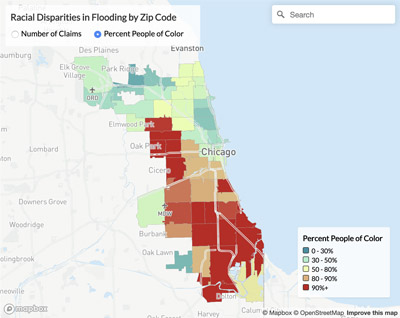During disasters, we focus on crisis management: treating the sick and providing the basic services we need to survive. Right now, we need support for the frontline public health workers and emergency service providers who are dealing with this crisis firsthand, and economic assistance for the retail and hospitality and service workers who have lost their jobs. We applaud the foundations and individuals who are giving generously to these necessary causes.
I am not the first person to note that the crisis of COVID-19 is not unlike past natural disasters that have been magnified by climate change – one of our fields of work at CNT. While this emergency has little to do with climate, there are useful parallels. In climate resilience, we talk about “stresses,” long-term trends that increase vulnerability, and “shocks,” sudden events that expose this vulnerability. The COVID-19 virus, and the economic damage that accompanies it, has brought into sharp relief the extreme wealth and income inequality in our society.
CNT is not a frontline service provider. Our staff of researchers, advocates, and planners have been fortunate to be able to shift our jobs to work from home. Many are not so lucky – being able to earn a salary from home is a mainly a privilege for higher-income professionals.
Once the time for emergency response has passed, disasters are followed by recovery. To use a climate metaphor: As the floodwaters recede, we will see the extent of the damage done to our cities and society, and the difficult path to recovery. We can already discern some of the outlines.
Making predictions during a volatile period is always a dangerous exercise, but as a reader of science fiction (currently reading Nnedi Okorafor, with Ada Palmer up next) I believe that telling stories about the future helps us have difficult discussions about today. So here goes:
Public transportation is the lifeblood of our cities, and one of the services that could be impacted long-term by COVID-19. Many of the essential jobs that keep our cities running are held by people who rely on public transit. But ridership has plummeted in the past two weeks, and with it, the revenue that transit needs to operate. Many of our friends, like the Active Transportation Alliance and Transportation for America, have called for Congress to provide the resources needed to keep these systems running. We strongly support these campaigns and others like them.

But there are longer-lasting problems that predated this crisis and will still be there, amplified, after it recedes. Public transit was already struggling before March 2020. Transit ridership has been falling in most cities, due to competition from ridehailing services (like Uber and Lyft), stagnant federal funding, rising rents in areas near train stations that force transit-dependent people to move elsewhere, and many other factors. Even beyond the lost ridership and revenue occurring now, the immediate future looks very challenging. Will the economic downturn reduce other revenue that transit agencies depend on, like sales tax? Will stock market losses expose public pension funding shortfalls, further reducing funding for daily operations?
To this set of financial problems, add speculative ones: Will our new societal discomfort with proximity to other people take time to fade? And will professionals – who are now investing money and time in learning how to effectively work from home – return to everyday commutes? Once we get used to this new normal, it’s going to be hard to change direction.
This is just one example. Consider also the newfound necessity for online shopping for nearly all products, and the resulting systems and expectations. Projecting that into the future isn’t a stretch.
It’s possible, of course, that our current situation is purely temporary, and the world will return to normal shortly. But the trends I described above aren’t new: they’re continuations of what has been happening already. Could the COVID-19 crisis be the “shock” that’s uncovering the flaws in our systems and causing the future to get here faster?
Build Back Better
A key concept in resilience is “Building Back Better.” When disaster strikes, rather than seeking to return to the status quo – with all of its now-exposed disparities and problems – we should look to improve upon it. We need investment that not only provides needed immediate economic support, but simultaneously reduces poverty and improves sustainability.
Right now, our focus should be on emergency management. But before too long, we need to start asking questions about what happens after the flood. I posed a few of those above – and we’d like to hear more. What are your ideas, thoughts, and concerns? Send them to info@cnt.org.
Stay healthy and keep your thoughts on the future. Better times will come, and we need to be ready to shape them together.





 Strengthening Transit Through Community Partnerships
Strengthening Transit Through Community Partnerships